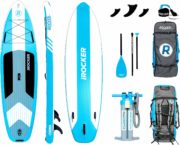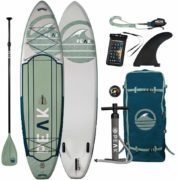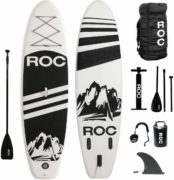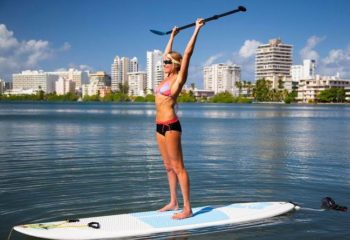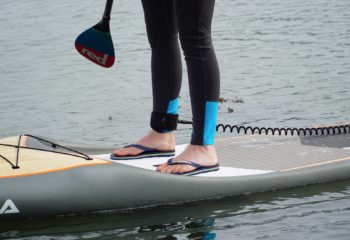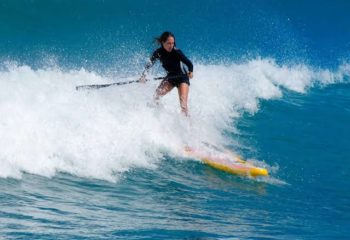Because paddleboarding looks so fun and recreational, not many people would think that it’s just an activity to do...
List of the Best Paddleboards
1. iROCKER Cruiser Inflatable Stand Up Paddle Board
Pros
- Carries up to 400lbs of weight
- Floating fiberglass paddle, so you don't have to worry about losing it
- Comes with a dual-chamber, triple action hand pump
Cons
- May have limited quality control as it gets holes easily
- After-sales service may not be much help
Bottom Line
Overall, the iROCKER Cruiser Inflatable Stand Up Paddle Board provides us with an excellent paddleboard that comes with many new features and improvements that we can all enjoy. Its fiberglass paddle is a great highlight, which is both lightweight and versatile, and with its full-frame, you can expect a stable ride through the water. Even with its apparent quality issues, this product's value far exceeds its flaws and can be forgiven.
Providing us with a high-quality paddleboard, iRocker has achieved in delivering a product that gives us value for money. From its lighter weight and broader frame, along with its great new features and updated pump, this inflatable paddle board is the best choice for adventurers. The iROCKER Cruiser Inflatable Stand Up Paddle Board is a brilliant new addition to your adventure list and is something you'll be able to enjoy with your family and friends for a long time.
Read our in-depth iROCKER Cruiser Inflatable Stand Up Paddle Board Review here.
2. Peak Expedition Inflatable Stand Up Paddle Board
Pros
- 3-piece aluminum adjustable travel paddle
- Uses a high-pressure dual-action pump
- Comes with a removable travel fin
Cons
- May have problems with a weak paddle
- May develop a reverse camber, making the rocker completely go away
Bottom Line
The Peak Expedition Inflatable Stand Up Paddle Board is an excellent addition to any explorer's arsenal, to get back out to nature and to get the most out of your travels. Its sturdy and robust construction allows you to go where none have gone before, and its high-pressure pump will enable you to get to the action quickly. Even with its minor setbacks, this paddleboard is still one of the closest products to boarding perfection that is out in the markets now.
In the end, the Peak Expedition Inflatable Stand Up Paddle Board is a brilliant product to use for all your adventures, whether it's fishing or touring or snorkeling. It's excellent features offer durability, portability, and value to anyone who loves the water and exploring its vastness. And with its free bundle and 1-year warranty, no other competitors have a better offer than this paddleboard. So what are you waiting for?
Read our in-depth Peak Expedition Inflatable Stand Up Paddle Board Review here.
3. FunWater Inflatable 10’6×33″×6″ Ultra-Light Paddle Board
Pros
- Made from PVC to strengthen the board without the added weight
- Portable and easy to carry
- Includes many extras in its package
Cons
- May have stabilization issues
- The pump may be weaker and might break prematurely
Bottom Line
The FunWater Inflatable Ultra-Light Paddle Board delivers excellent performance with an almost perfect product. But because of their neglect towards customer feedback as well as making sure of the quality of their pump, they miss out on delivering a paddleboard that could've been perfect. But for the price of $250, this is still one of the best paddleboards within its price tag and even ones that are supposed to give better value because it comes at a higher cost.
All in all, the FunWater Inflatable Ultra-Light Paddle Board still provides us with many features and capabilities for its lower price tag. It is both durable for all your adventures and versatile enough to be taken anywhere from your pool, to the lake or the ocean. It even comes with a lot of useful freebies from the package that comes with it, making sure that you get everything you need at no extra price. For all your paddleboarding needs, the FunWater Inflatable Ultra-Light Paddle Board is the right choice.
Read our in-depth FunWater Inflatable 10’6×33″×6″ Ultra-Light Paddle Board Review here.
4. SereneLife Inflatable Stand Up Paddle Board
Pros
- Comes with a wide SUP design
- Made with a non-slip, soft top deck
- Durable and portable, perfect for adventures
Cons
- Paint could start peeling after only a few weeks
- May have problems with stability
Bottom Line
In the end, the SereneLife Inflatable Stand Up Paddle Board has many things to offer for those who love to explore and go out for adventures on the water. With its excellent design and maneuverability, it is well suited for kids and adults alike who want to learn and those who are already pros at paddleboarding. Its portability lets you take it wherever you want to go; from rivers, lakes, and oceans.
The SereneLife Inflatable Stand Up Paddle Board gives you all the essentials you need for all your travels which provides you with great value for your money. All in all, this paddleboard is still worth the price despite the few mistakes in its manufacturing and we hope that the company will be open to customer feedback so that they can take suggestions on board and finally perfect this product that already comes close to it.
Read our in-depth SereneLife Inflatable Stand Up Paddle Board Review here.
5. Roc Inflatable Stand Up Paddle Boards
Pros
- Durable and lightweight, making it ideal for all your adventures
- Comes with complete with all the essentials you need
- An excellent, all-around board for all skill levels
Cons
- May quickly get holes after a few uses
- The paddle may be weaker than expected and may break
Bottom Line
While the Roc Inflatable Stand Up Paddle Board comes up short with a few things such as it's paddle and overall quality of the board, it's not a huge disappointment overall. It gives customers a high-quality and lightweight product, a functional design, and a whole essentials package that contains everything you could need to get you started on your adventures.
To sum it up, the Roc Inflatable Stand Up Paddle Board is an excellent paddleboard to add to your collection or to give as a gift to your children. It will not only pave the way to a lifetime of paddling and fun, but it will also help them take the first steps towards loving adventure and exploration. This paddleboard takes its rightful place in this list of the top paddleboards for 2019 and can be yours soon.
Read our in-depth Roc Inflatable Stand Up Paddle Boards Review here.
